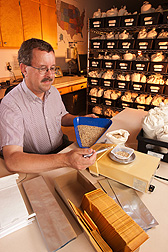 A lot of research has gone into studying sweet sorghum’s potential as a bioenergy crop. The U.S. Department of Agriculture (USDA) has found that there are several attributes of the feedstock that make it uniquely suited to produce biofuels. One assest is its lower need for water, making it an ideal crop to grow in drought prevalent areas. In addition, it has low nitrogen fertilizer requirements and high biomass content. This according to molecular biologist Scott Sattler and Jeff Pedersen with USDA’s Agricultural Research Service (ARS).
A lot of research has gone into studying sweet sorghum’s potential as a bioenergy crop. The U.S. Department of Agriculture (USDA) has found that there are several attributes of the feedstock that make it uniquely suited to produce biofuels. One assest is its lower need for water, making it an ideal crop to grow in drought prevalent areas. In addition, it has low nitrogen fertilizer requirements and high biomass content. This according to molecular biologist Scott Sattler and Jeff Pedersen with USDA’s Agricultural Research Service (ARS).
Sweet sorghum produces sugar that can be converted to biofuel. The fibers in the feedstock left over after the juice is extracted can be burned to create electricity. Sorghum and sugarcane are good crops for the southeastern part of the U.S. because they are complementary crops and can extend the biofuel production season. Both feedstocks also use the same equipment so a grower would not need to invest in new technology to plant or harvest either crop.
The sweet sorghum research is part of USDA’s work in studying biofuel crops to meet the Renewable Fuel Standard (RFS) mandate of 36 billion gallons of biofuel by 2022. Of this total, 21 billion gallons will come from sources other than grain-based ethanol, of which sweet sorghum is one possible feedstock.
Other teams are also studying sweet sorghum including a group led by geneticist William Anderson with the ARS Crop Genetics and Breeding Research Unit in Tifton, Georgia. This team is working on identifying desirable bioenergy genes and working on improving them. To date, the team has studied 117 genotypes from the ARS sorghum germplasm collection with more research underway.

